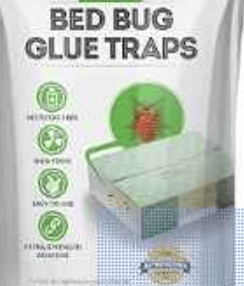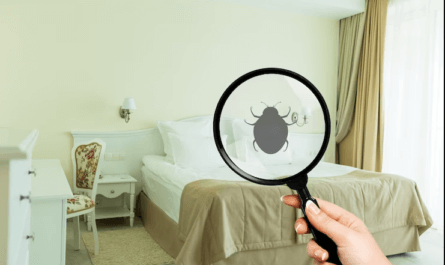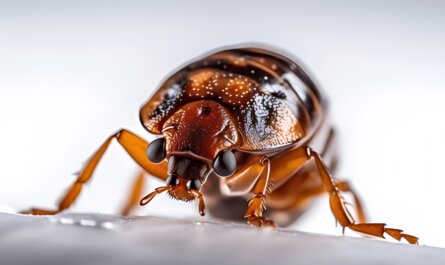Bed bugs are annoying and difficult to get rid of, but catching them doesn’t have to be intimidating. Glue traps for bed bugs are sticky sheets that can capture the insects, making it easier to identify and monitor a bed bug infestation in your home.
In this blog post, we’ll discuss how effective glue traps can be and provide detailed instructions on how to properly use them. With our practical tips and advice, you will learn all you need know about using glue traps as a safe bed bug management tool!
What are Bed Bug Glue Traps?
Glue traps are designed with sticky adhesive surfaces to capture bed bugs and reduce the number of insects in an infested space.
How do they work?
Glue traps for bed bugs are disposable and ready-to-use contraptions, made up of a sticky adhesive to capture bed bugs. Due to the strong glue on the trap, bed bugs are unable to escape or crawl away, making them an effective method of monitoring a potential infestation as well as controlling it.
Moreover, these traps can also catch other insects that resemble bed bugs such as cockroaches and carpet beetles. Bed bug glue traps need to be set up in areas likely to have high numbers of pests like beds and couches with gaps in seams and furniture joints; each trap should be carefully checked regularly for signs of vermin presence.
Furthermore, these traps must be replaced when they become dirty from dust or hair so there is no interference with trapping other household pests. Glue traps for bedbugs are arguably one of the easiest methods used by pest control professionals both residential homes and industry facilities due those its convenience without necessarily resorting to chemical treatments.
How to Use Glue Traps for Bed Bugs
Find out the right steps you should follow in order to effectively use glue traps and reduce bed bug infestation.
Careful setup
To use glue traps for bed bugs effectively and ensure successful catching or detection of these pests, careful setup is paramount. Glue traps should be placed in areas where bed bugs are likely to travel such as along baseboards, under furniture and near the head of the bed. It is important to choose an appropriate size and type of trap for monitoring or capturing depending on the size and type of activity expected from the bug’s infestation. Before placing a glue trap it is imperative that all obstruction such as dust, debris, pet hairs etc.
Must be removed from its surface so that it may remain effective. When positioning a trap with adhesive side up make sure non-sticky bottom points up towards flooring or surface level being addressed in order to minimize chances of mishap caused due to shifting.. Regular inspection after every two days is recommended so you may idealize about current situation before replacing your existing traps with new ones if required due uneven distribution caused by intense presence
Proper placement
When it comes to using glue traps for bed bugs, proper placement is key. Glue traps should be placed between beds and other furniture in the bedroom to monitor insects entering your home or rental space. They can also be strategically placed in areas of frequent activity and where bed bugs are most likely to hide like behind electrical outlets, door frames, under rugs, on dressers and nightstands or near curtains.
Traps should overlap so that multiple areas are covered – corners where walls and floors meet tend to gather more bugs since they’re out of sight. Additionally, use a sufficient number of glue traps for an adequate amount of bug coverage throughout the room or home depending on its size.
For travelers staying in hotels or Airbnbs, place one trap beneath each side of the bed as well as additional ones around room edges and along headboards/desks/dressers/other furniture pieces for maximum effectiveness. It is important to note that although tape traps can also help detect infestations, they may be slightly less effective than glue traps because moisture can make them lose their stickiness after just a few days whereas glue remains adhesive when wet for extended periods
Replacing traps
Having effective bed bug control depends on the regular replacement of traps. Whether you are using glue traps or tape traps, it is important to replace them in order for them to remain an effective tool in capturing and trapping bed bugs. Bed bug glue traps can also catch other common household bugs, so replacing them regularly ensures your trap remains targeted towards your chosen pest.
Moreover, although research evidence regarding the effectiveness of sticky traps for monitoring bed bugs is limited, regular replacements are necessary if they are being used as a means of identification. Through this way, such inexpensive yet disposable tools become a cost-effective approach to bed bug control.
Furthermore, integrated pest management (IPM) approach also emphasizes the need for regular trap replacements which should be taken into account when planning how often these should be changed in order to ensure successful long term extermination efforts against bedbugs and other pests.
Effectiveness of Glue Traps for Bed Bugs
Glue traps for bed bugs can be an effective tool in the home treatment of a bed bug infestation. The sticky surface of glue traps attracts the insects as they move around, allowing them to be trapped.
Since their movements are often difficult to detect, setting up these simple devices can help detect and confirm the presence of bed bugs in your home or other area. Used correctly, they can reduce the number of pests within a given space and alert you to take additional steps if needed.
For successful trapping with glue bedsbugs it is essential that careful setup and proper placement are done—placing one trap per room is recommended. Additionally, regular monitoring is required: some manufacturers recommend replacing independent use glue traps at least twice per month whereas professional pest control requires much more frequent inspection – often once every two weeks depending on level of infestation.
Glue traps are not always 100% efficient but used in conjunction with other methods listed by health organizations may contribute significantly towards reducing an infestation problem under certain circumstances – sacrificing accuracy for less resource intensive solutions.
Where to Buy Bed Bug Glue Traps
Consider buying quality Glue Traps from reliable brands to ensure complete bed bug capture.
Recommended products and brands
For those seeking to combat bed bug infestations, considering the use of glue traps is an affordable and effective solution. Here are some recommended products and brands that have proven to be reliable in dealing with bed bugs:
| Brand | Product Name | Description | Effectiveness | Affordability |
|---|---|---|---|---|
| Expel | Glue Trap | This trap is made with an extra-strength adhesive sticky glue and a pre-scented attractant. It is disposable and ready-to-use, making it an easy option for homeowners, renters, landlords, and pest control professionals. | With its ready-to-use glue traps, Expel efficiently captures bed bugs in areas of known activity and harborage. | Expel Glue Traps are an affordable choice, making them an ideal option for a budget-friendly solution. |
| BuggyBed | Glue Trap | This glue trap uses extra-strong adhesive and a pre-scented attractant to lure bed bugs. As a disposable and readily available tool, it’s a practical solution for parents, travelers, and individuals living in urban areas. | BuggyBed traps are highly effective in capturing bed bugs, providing a reliable solution for those dealing with infestations. | Despite its high effectiveness, BuggyBed traps remain an affordable solution to bed bug problems. |
| Hot Shot | Bed Bug Glue Trap Detector Indoor Insect Trap | This product is designed to detect and trap bed bugs. It’s an ideal choice for Airbnb hosts, healthcare facilities, and second-hand furniture buyers. | Hot Shot’s Glue Trap Detector is effective in capturing bed bugs, helping users identify areas of infestation. | This product provides cost-effective detection and trapping of bed bugs, making it a valuable tool in any pest management arsenal. |
These top-rated brands offer highly effective and cost-effective glue traps for bed bugs, ensuring you can keep your home or business free of these unwelcome pests.
Conclusion
Glue traps are an effective way to identify and reduce bed bug infestations. They provide a safe and non-toxic way of controlling bed bugs, as well as many other pests. With careful setup and placement, glue traps can be used to capture live or dead adult bed bugs, along with their eggs.
Moreover, they can aid in prevention efforts by detecting potential issues even before the infestation has started. Glue traps should be placed strategically around known harborages such as furniture legs or baseboards for best results.
Also regular monitoring is essential for catching any new activity and replacing aging glue liners when necessary. By using these combined pest control methods together wearers more likely to have success eliminating bedbugs once and for all from your home or facility!
FAQs
1. Where should I put glue traps for bed bugs?
Glue traps for bed bugs should be placed near areas where they are likely to hide, such as mattress seams, box springs, and headboards.
2. How often do I need to change the glue traps?
According to experts, you should check your glue traps at least once a week and replace them when needed. It is also advisable to change the placement of the trap in order to catch more pests.
3. What else can I do if I cannot get rid of all the bed bugs with glue traps?
If you cannot eradicate an infestation using only glue traps, it’s best to contact a professional exterminator who has special equipment and experience dealing with such insect pests.
4. Will regular fly paper work on bedroom bugs?
Regular fly paper will not effectively capture or eliminate bed bug populations from your home – instead use specially designed insecticidal sprays or chemical treatments aimed specifically against bedbugs.




